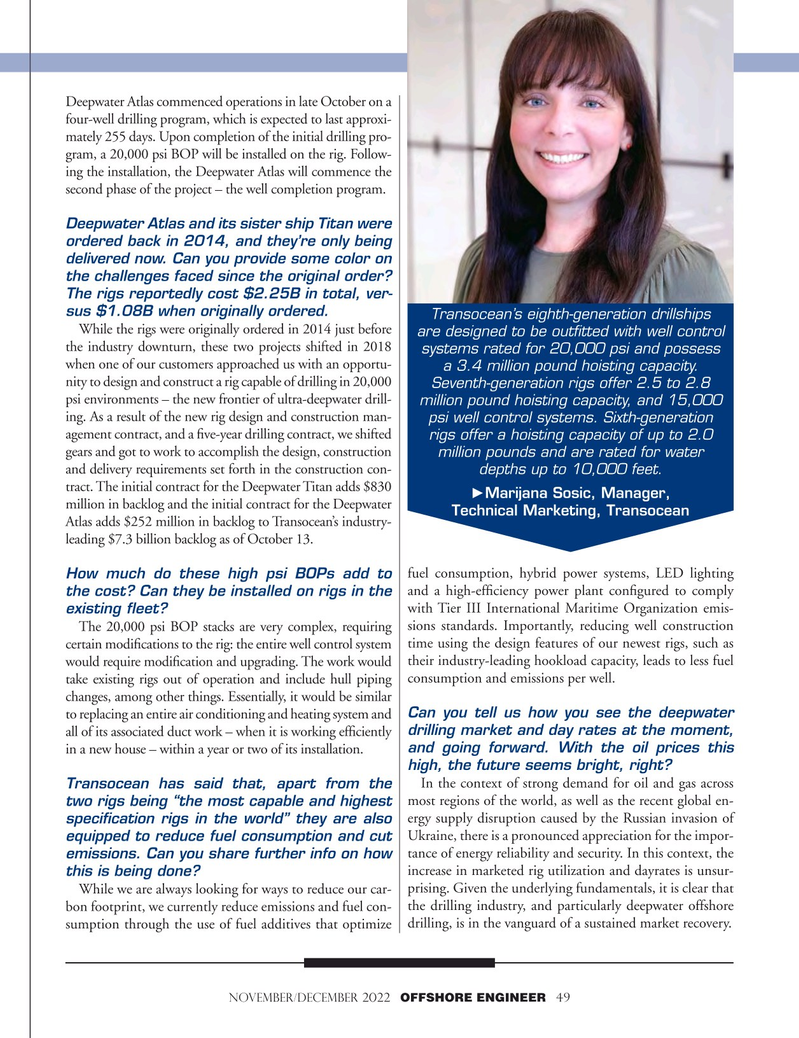
Page 49: of Offshore Engineer Magazine (Nov/Dec 2022)
Read this page in Pdf, Flash or Html5 edition of Nov/Dec 2022 Offshore Engineer Magazine
Deepwater Atlas commenced operations in late October on a four-well drilling program, which is expected to last approxi- mately 255 days. Upon completion of the initial drilling pro- gram, a 20,000 psi BOP will be installed on the rig. Follow- ing the installation, the Deepwater Atlas will commence the second phase of the project – the well completion program.
Deepwater Atlas and its sister ship Titan were ordered back in 2014, and they’re only being delivered now. Can you provide some color on the challenges faced since the original order?
The rigs reportedly cost $2.25B in total, ver- sus $1.08B when originally ordered.
Transocean’s eighth-generation drillships
While the rigs were originally ordered in 2014 just before are designed to be outfitted with well control the industry downturn, these two projects shifted in 2018 systems rated for 20,000 psi and possess when one of our customers approached us with an opportu- a 3.4 million pound hoisting capacity. nity to design and construct a rig capable of drilling in 20,000
Seventh-generation rigs offer 2.5 to 2.8 psi environments – the new frontier of ultra-deepwater drill- million pound hoisting capacity, and 15,000 ing. As a result of the new rig design and construction man- psi well control systems. Sixth-generation agement contract, and a ?ve-year drilling contract, we shifted rigs offer a hoisting capacity of up to 2.0 gears and got to work to accomplish the design, construction million pounds and are rated for water and delivery requirements set forth in the construction con- depths up to 10,000 feet. tract. The initial contract for the Deepwater Titan adds $830
Marijana Sosic, Manager, million in backlog and the initial contract for the Deepwater
Technical Marketing, Transocean
Atlas adds $252 million in backlog to Transocean’s industry- leading $7.3 billion backlog as of October 13.
How much do these high psi BOPs add to fuel consumption, hybrid power systems, LED lighting the cost? Can they be installed on rigs in the and a high-ef?ciency power plant con?gured to comply existing fleet? with Tier III International Maritime Organization emis-
The 20,000 psi BOP stacks are very complex, requiring sions standards. Importantly, reducing well construction certain modi?cations to the rig: the entire well control system time using the design features of our newest rigs, such as would require modi?cation and upgrading. The work would their industry-leading hookload capacity, leads to less fuel take existing rigs out of operation and include hull piping consumption and emissions per well.
changes, among other things. Essentially, it would be similar to replacing an entire air conditioning and heating system and Can you tell us how you see the deepwater all of its associated duct work – when it is working ef?ciently drilling market and day rates at the moment, in a new house – within a year or two of its installation. and going forward. With the oil prices this high, the future seems bright, right?
Transocean has said that, apart from the In the context of strong demand for oil and gas across two rigs being “the most capable and highest most regions of the world, as well as the recent global en- specification rigs in the world” they are also ergy supply disruption caused by the Russian invasion of equipped to reduce fuel consumption and cut Ukraine, there is a pronounced appreciation for the impor- emissions. Can you share further info on how tance of energy reliability and security. In this context, the this is being done? increase in marketed rig utilization and dayrates is unsur-
While we are always looking for ways to reduce our car- prising. Given the underlying fundamentals, it is clear that bon footprint, we currently reduce emissions and fuel con- the drilling industry, and particularly deepwater offshore sumption through the use of fuel additives that optimize drilling, is in the vanguard of a sustained market recovery. november/december 2022 OFFSHORE ENGINEER 49

 48
48

 50
50